Amanita echinocephala (Vittad.) Quél. - Solitary Amanita
Phylum: Basidiomycota - Class: Agaricomycetes - Order: Agaricales - Family: Amanitaceae
Distribution - Taxonomic History - Etymology - Identification - Culinary Notes - Reference Sources

Despite its common name this rare (in Britain and Ireland) mushroom does not always occur singly, although it cannot be described as gregarious because it is most unusual to find more than two or three in close proximity.
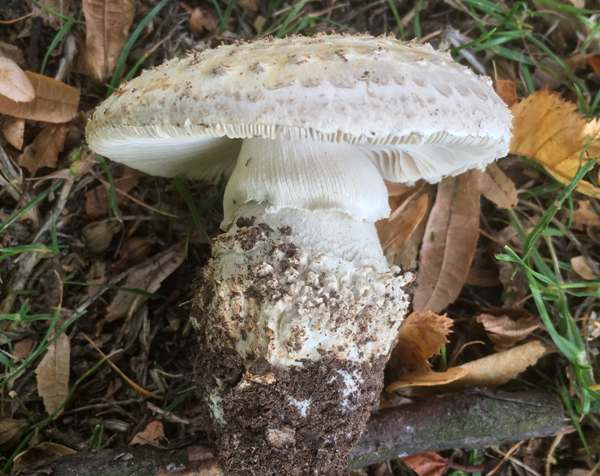
In the early stages of fruitbody development the emerging buttons look very much like those of Amanita muscaria (which rarely has a white form), but as the caps expand no red background is revealed and the pointed warts simply separate to reveal a white or cream cap skin.
For a detailed description of the Amanita genus and identification of common species see our Simple Amanita Key...
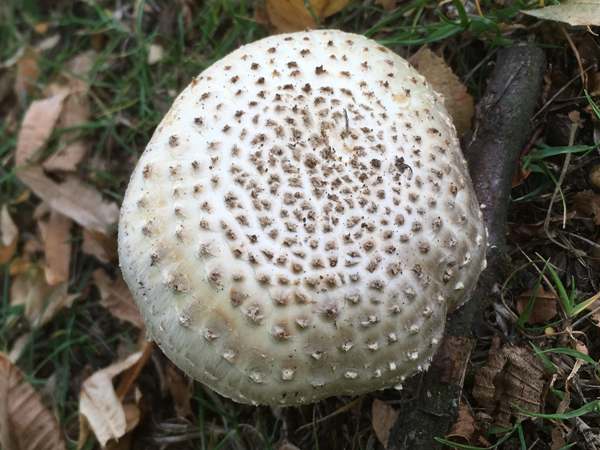
Distribution
Very rare in Britain and Ireland, Amanita echinocephala is mainly restricted to alkaline soils typical of the beechwoods of southern England, with just a few reports from Yorkshire (also on calcareous soil). The Solitary Amanita ocurs also in parts of mainland Europe.
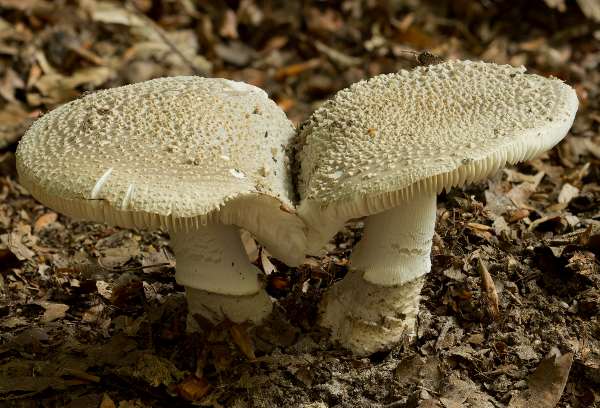
This species does not occur in North America, where several other white-capped amanitas with warty caps are found, among which is Amanita cokeri, a mushroom very similar in appearance to Amanita echinocephala.
Taxonomic history
First described as Agaricus echinocephalus (most of the gilled mushrooms were included initially in the genus Agaricus!) in 1835 by Italian mycologist Carlo Vittadini, this mushroom was moved into the genus Amanita by Lucien Quélet, who gave it the binomial name that it retains to this day.
Common synonym of Amanita echinocephala include Amanita solitaria (Bull. ex Fr.) Secr. and Amanita strobiliformis var. aculeata Quél. This is a very rare species in Britain and Ireland, and its fruitbodies should not be picked. (The pictures shown here are courtesy of Nigel Kent, who retains the copyright.)
Etymology
The specific epithet echinocephala comes originally from the Greek words "e'chinos" (meaning hedgehog, and also sea-urchin - both of which are spiny!) extended with "cepha'le" (meaning head). These words later entered into Latin, giving the prefix echino- meaning spiny or spiky and cephalum meaning a head. Hence echinocephala means 'with a spiny head'.
Identification guide
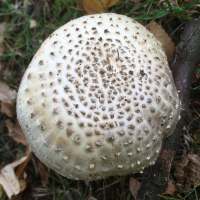 |
CapGlobose becoming convex and then flattened, usually with a down-turned rim; smooth and white or cream, covered with creamy wart-like veil remnants in the form of pointed scales, although in wet weather many of the warts may wash off; margin ragged with veil fragments; diameter up to 15 cm. Beneath the pellicle the flesh of the cap is white and firm. |
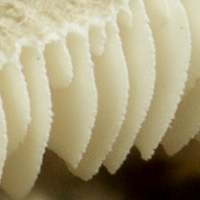 |
GillsNarrowly adnexed or free and crowded; creamy white, often with a slight greenish tinge. |
 |
StemCreamy white, 8 to 16cm tall and 1 to 2cm diameter, swollen towards a deeply rooting pointed base that bears volval remains. Ring creamy white, fleshy and somewhat floppy and hanging (pendulous) at maturity. |
SporesEllipsoidal, smooth, 9.5-11.5 x 6.5-8µm; amyloid. Spore printWhite. |
|
Odour/taste |
A faint, unpleasant odour; suspect and so this mushroom should not be tasted. |
Habitat & Ecological role |
Mycorhizal with hardwoods and possibly occasionally with coniifers, the Solitary Amanita is found in mixed woodland usually on dryish calcareous soil. This species is also known to associate with Common Rockrose in grassland well away from trees. |
Season |
July to November in Britain. |
Similar species |
Amanita citrina has white velar remains on a white or pale lemon cap but not in pyramidal form; it has a fragile pendent ring. Amanita strobiliformis also has a warted white cap with ragged veil fragments hanging from the cap margin; at maturity its cap remains domed rather than flattening out. |
Culinary Notes
The Solitary Amanita is not an edible species, and even if it were there is grave risk that inexperienced foragers might confuse it with Amanita virosa, the Destroying Angel, with catastrophic consequences. Shun all white Amanita species - or live by the even safer if ungrammatical maxim "Never eat a Amanita".
Reference Sources
Fascinated by Fungi, 2nd Edition, Pat O'Reilly 2016, reprinted by Coch-y-bonddu Books in 2022.
Funga Nordica: 2nd edition 2012. Edited by Knudsen, H. & Vesterholt, J. ISBN 9788798396130
BMS List of English Names for Fungi
Geoffrey Kibby, (2012) Genus Amanita in Great Britain, self-published monograph.
Paul M. Kirk, Paul F. Cannon, David W. Minter and J. A. Stalpers (2008). Dictionary of the Fungi; CABI
Taxonomic history and synonym information on these pages is drawn from many sources but in particular from the British Mycological Society's GB Checklist of Fungi.
Acknowledgements
This page includes pictures kindly contributed by Simon Harding and David Kelly.
Fascinated by Fungi. Back by popular demand, Pat O'Reilly's best-selling 450-page hardback book is available now. The latest second edition was republished with a sparkling new cover design in September 2022 by Coch-y-Bonddu Books. Full details and copies are available from the publisher's online bookshop...

